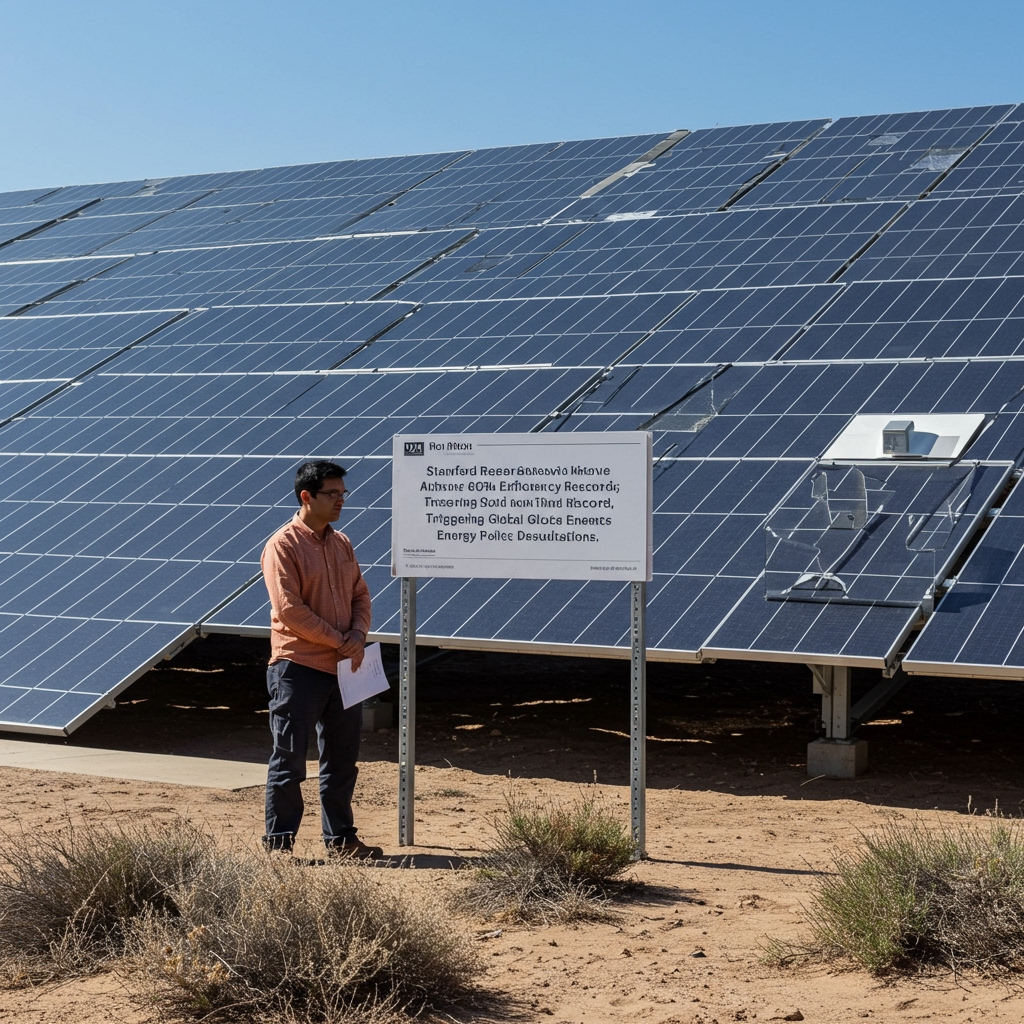Quantum Leap Announced
In a development poised to redefine the trajectory of renewable energy deployment, researchers at the esteemed Quantum Energy Research Institute at Stanford University have announced a monumental breakthrough in photovoltaic technology. On April 14, 2025, the institute’s team, spearheaded by the distinguished Dr. Anya Sharma, revealed the successful creation of a photovoltaic cell that has achieved an unprecedented solar-to-electricity conversion efficiency of 60% under rigorously controlled laboratory conditions. This figure represents a significant leap beyond previous records and underscores the potential for a radical transformation within the solar energy landscape.
The details of this landmark achievement were first disseminated via a pre-print publication on the prestigious Nature Energy platform, signaling the scientific community’s eagerness to share and scrutinize the findings. The announcement was met with immediate and widespread attention, resonating across scientific, industrial, and governmental sectors due to its profound implications for the future of clean energy generation.
Significance of the 60% Benchmark
The attainment of 60% efficiency is not merely an incremental improvement; it signifies a paradigm shift in how solar energy can be harvested. Current commercially available solar panels typically operate at efficiencies ranging from 15% to 22%, with cutting-edge laboratory examples previously reaching into the mid-to-high 40s under specific, often complex, conditions. A jump to 60% efficiency means that substantially less surface area would be required to generate the same amount of electricity. This has direct, tangible benefits:
Firstly, it dramatically reduces the land footprint needed for large-scale solar farms, addressing concerns about land use conflict and enabling deployment in areas where space is limited or at a premium. Secondly, it promises a potential reduction in manufacturing costs per unit of energy produced. While the cell technology itself might be complex, the need for fewer panels, supporting structures, wiring, and installation labor per megawatt of capacity could lead to significant overall system cost reductions. This scalability improvement could accelerate the economic viability of solar power in diverse applications, from utility-scale plants to distributed residential and commercial rooftop installations.
Dr. Sharma and her team’s work suggests that future solar installations could be smaller, lighter, and potentially more cost-effective, making solar energy an even more compelling alternative to fossil fuels and bringing ambitious global climate goals closer to reach.
Immediate Global Policy Response
The gravity of the Stanford breakthrough was not lost on global leaders and energy policymakers. The announcement on April 14, 2025, immediately triggered urgent high-level discussions among key international stakeholders. Representatives including G7 energy ministers, officials from the International Energy Agency (IEA), and executives from major global energy corporations convened swiftly to deliberate on the implications and necessary next steps.
The agenda of these critical discussions has reportedly centered on several key areas. Expediting research funding for follow-on studies, scalability research, and potential manufacturing pathways for the new cell technology is a top priority. Protecting the intellectual property through strategic patenting is also under urgent review to ensure orderly development and deployment. Furthermore, the discussions are exploring potential policy adjustments required to capitalize on this breakthrough rapidly. This includes reviewing and potentially modifying existing energy legislation and proposals.
A specific focus has been placed on proposed legislation such as the U.S. “Clean Energy Acceleration Act of 2025.” Policymakers are considering fast-tracking provisions within such bills to facilitate the research, development, and potential commercialization of this high-efficiency technology, removing bureaucratic hurdles that could slow its path from the laboratory to the market. The unified and rapid response from such diverse global bodies underscores the perceived transformative potential of the 60% efficiency mark and the urgent desire to harness it for climate action and energy security.
Challenges and Future Outlook
While the scientific achievement is undeniably historic, the path from a laboratory demonstration to mass-produced, commercially viable technology presents significant challenges. Key among these is the feasibility of scaling up the manufacturing process for these advanced cells. The materials, techniques, and required infrastructure for producing cells at this efficiency level on a mass scale need extensive research and development. The cost-effectiveness of mass production is also a critical factor that will determine market penetration. Novel manufacturing processes often come with high initial costs, and bringing these down to competitive levels will require substantial investment and innovation.
Despite these significant hurdles, the researchers and policymakers remain optimistic. The 60% efficiency breakthrough is universally regarded as a critical step – a proof of concept that demonstrates the theoretical potential and provides a concrete target for future engineering and manufacturing efforts. The urgency reflected in the high-level discussions indicates a collective will to overcome these challenges rapidly. The integration of this technology into global energy systems, while not immediate, now seems a much more attainable goal, offering a powerful new tool in the world’s effort to meet ambitious global climate goals and transition towards a sustainable energy future.





